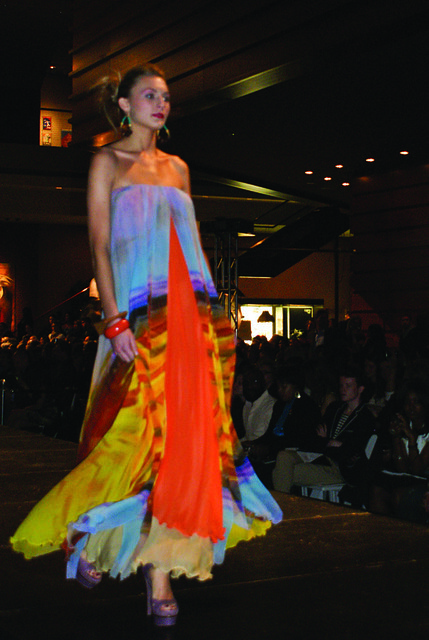Columnist Alexis Sachdev reviews the first PIFA fashion show which featured 1920s Paris style.
When fellow “Hoot Couture” columnist Mark Longacre and I stepped into the Kimmel Center last Friday evening, we felt as though we immediately had been teleported into 1920s Parisian Paris. The disc jockey spun music appropriate for French film noirs, rife with accordions and violins. Low lighting cast a romantic-yet-edgy glow on the lobby and a scaled-down replica of the Eiffel Tower adorned with thousands of light bulbs, stood just feet from the end of the runway to add to the spectacle.

The first-ever Philadelphia International Festival of the Arts held its fashion show on April 8, and the stage was set for what was expected to be a very stylish evening.
The appropriate theme of French fashion welcomed local student designers and Philadelphia’s professional sartorialists famous throughout the city, including Carmelita Martell of Carmelita Couture and Ralph Rucci, a famed Temple alumnus whose designs have graced New York runways.
The show commenced with student designs from various schools in the area, including Drexel University, Moore College of Art and Design, Philadelphia University and University of Delaware.
The unifying detail between students and professionals alike for spring was long hemlines. Every designer featured at least one billowy maxi dress or a formal gown with floor-sweeping hems.
Among my favorites was a strapless maxi gown by Carmelita Couture with an eye-popping blue, yellow and orange print. Crafted with multiple layers of light, sheer chiffon, this dress fluttered flatteringly behind the model as she strutted down the runway.
Remember the Disney story of our youths, “Beauty and the Beast”? Coincidentally enough, this famous fairy tale took place in pastoral France, and one could very easily draw a parallel to sum up the event: There were beauties, and there were beasts.
A princess ball gown by Melanie Brandon of Melanie Von Alexandria was just a train wreck waiting to happen. I breathed “oohs” and “ahhs” as the model entered the runway, but as she stepped closer, I regretted my initial reaction. The dress, in an iridescent pearl silk, was covered with blue LED lights. The model looked like a life-size Christmas tree angel.
I’m sorry. I love couture and all things girly, but some (read as: most) of the designs people consider “fabulous” and “luxurious” are just ridiculous and impractical. I’m not going to prance around Philadelphia with lights twinkling around my ass looking like a Tooth Fairy imposter.
But an element of the show I truly enjoyed was the apparent resurgence in neutral colors – primarily black, charcoal and nude. Nearly every designer presented outfits with a dominating neutral color scheme, with the exception of perhaps one or two pieces.
Neutrals are your friends – no longer will you worry whether yellow or orange is the color for spring. You can never mismatch again. You can look chic without trying too hard.
With every rising tide, there too is a falling one. Sure, the colors were on-point, cuts and styles were fresh and modern while maintaining an air of yesteryear, and the show went on without a hitch. But there was one pivotal problem: No designer presented a line comprehensive enough for me to really judge.
At best, each line carried approximately seven looks. In a “real” fashion event, this number could easily be doubled or tripled. The show lasted only an hour and gave us just a lick of what could be a pretty tasty slice of cake.
Now, I’m craving that piece of cake. My hunger is spiked and my mouth is salivating, but I may never be satiated. The public relations agency for PIFA – Nina Zucker Associates – advertised the crap out of the whole festival. Unfortunately, the fashion show failed to fully deliver. I can only hope the disappointment last Friday doesn’t set the tone for the remainder of the month’s events.
Alexis Sachdev can be reached at asachdev@temple.edu.



Two things: the PIFA theme was inspired by the Paris Belle Epoque period. A time in which artists in various categories (music, sculpture, painting, etc) collaborated to create something new. Then there is the fact that Paris is the City of Lights. The designers in the PIFA show were asked to create six ensembles that reflected the Paris/Belle Epoque era.
The lighted designs were created by Janice Martin Couture, a designer of high fashion bridal and evening wear. For purposes of PIFA, however, she invited fellow designers Lee Wainwright, lighting designer whose last couture show was with Alexander McQueen… and Lonni Rossi, a local textile designer to work with her in creating gowns that reflected the creative/collaborative spirit of the Belle Epoque.
Perhaps an MC could have introduced the show so that there would be some perspective on what the audience (and opinionators) were to expect… collaboration, creativity, references to Paris, etc. The lighted gowns created by the three companies “nailed” the theme!
–Janice Martin
–Miko Green
–Lonni Rossi